Descrizione
L'opera "Agrada Tahitian Woman" (1902) di Paul Gauguin è un pezzo emblematico che incapsula gli elementi distintivi del suo stile post -impressionista e la sua visione personale del mondo tahiziano. In questo dipinto, Gauguin presenta una donna tahizia in una posa lasciata in eredità, formando un potente simbolo della profonda connessione tra l'essere umano e l'ambiente naturale. La figura femminile, con un'espressione serena e un corpo che si piega in avanti, suggerisce una posizione di introspezione e contemplazione. La sua pelle, un tono marrone caldo, evidenzia la connessione dell'artista con la cultura polinesiana e il suo rifiuto dell'ideale europeo.
La composizione è notevole per la sua semplice ma efficace gestione dello spazio. La figura centrale domina la tela, mentre lo sfondo è limitato a una rappresentazione suggestiva ma sottile della vegetazione tropicale. I colori vibranti e non naturalistici che usa Gauguin qui sono progettati per evocare le emozioni più che rappresentare fedelmente la realtà. Il blu e il verde predominano che incorniciano la donna, in contrasto con il tono caldo della sua pelle e l'uso di uno sfondo beige chiaro che simula la sabbia senza distrarre lo sguardo dello spettatore dalla figura centrale. Questi colori non solo contribuiscono al lavoro una qualità quasi onirica, ma riflettono anche l'influenza della cultura nativa e del suo ambiente.
Oltre alla figura principale, la "donna tahitiana accovacciata" invita lo spettatore a riflettere sulla condizione femminile nell'arte e nella società. Il fatto che Gauguin si infiltra tra le comunità di Tahiti per estrarre la sua essenza, sembra causare una dualità tra idealizzazione e realtà, ritraggendo una donna che, sebbene sia soggetta a contemplazione, emana anche una forte presenza e una profonda immobilità, come se il Il peso della sua esistenza ha caricato un senso di spiritualità. Questo lavoro, in larga misura, risuona con l'approccio di Gauguin verso il simbolismo. La sua intenzione era, evidentemente, trascendere il semplice ritratto fisico e connettersi con quelle che percepiva come verità più profonde dell'esistenza umana.
L'interesse di Gauguin per l'origine e il significato della vita in questo ambiente distante ed esotico si riflette nel modo in cui affronta la pittura. Ha scelto modelli nativi, che ha cercato di rappresentare non solo con fedeltà ai suoi caratteri, ma con una comprensione più profonda della sua identità culturale e spirituale. Questo approccio rivela sia il fascino che la complessità delle interazioni di Gauguin con i popoli indigeni, un tema ricorrente nel suo lavoro che può essere osservato in altri dipinti come "lo spirito dell'isola" o "visione dopo il sermone".
Alla fine, la "donna tahitiana accovacciata" non è solo una semplice rappresentazione di una donna, ma un'opera che incapsula il desiderio di Gauguin di accedere a una realtà più intensa e quasi mistica, in cui la figura femminile sembra essere in uno spazio liminale tra ciò che terrestre e spirituale. In un momento di cambiamento e ricerca artistica, Gauguin ha trovato a Tahiti un riparo, e questo pezzo è la prova del suo tentativo di comprendere e interpretare l'anima di una cultura diversa dalla tua, attraverso il linguaggio visivo rispetto a un solo linguaggio visivo maestre di colore e forma potrebbero raggiungere.
KUADROS ©, una famosa vernice sul muro.
Dipinti ad olio fatti a mano, con la qualità degli artisti professionisti e il distintivo sigillo di KUADROS ©.
Servizio di riproduzione delle immagini con garanzia di soddisfazione. Se non sei completamente soddisfatto della replica del tuo dipinto, rimborsiamo i tuoi soldi al 100%.

